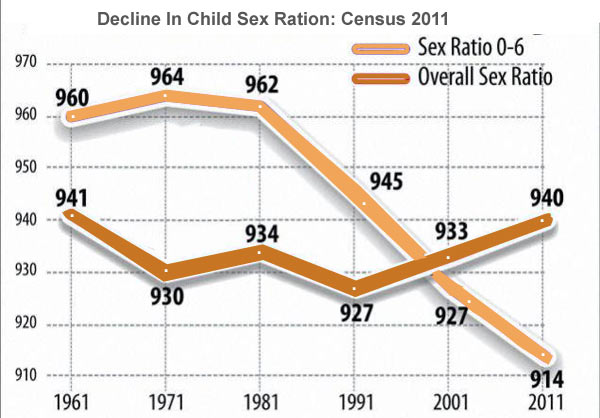Social Justice
Skewed Gender Ratio
This article is based on “The real population worry” which was published in The Indian Express on 17/10/2020. It talks about the worrisome trend in the decline of sex ratio at birth in India.
The recently released Sample Registration System (SRS) Statistical report (2018) which measures the global population projection, highlighted that fertility rate has been declining in India for some time now.
The report estimated that India’s Total Fertility Rate (TFR) was around 2.2 in the year 2018, which is close to the replacement rate of 2.1. This clearly marks the success of government measures to bring population control.
However, on flip side the SRS report highlights the declining sex ratio at birth in India that has further got reduced from 906 in 2011 to 899 in 2018. The United Nations Population Fund (UNFPA) State of World Population 2020 held that sex ratio at birth in India is lower than all the countries in the world except China.
Therefore, along with stabling of population , government and society needs to address the declining sex ratio and subsequenlty gender discrimination.
Reasons For Skewed Sex Ratio
- Gender Bias: According to information from the UNPFA, reasons for female infanticide include anti-female bias, as women are often seen as subservient to men, who often employ positions of power.
- Son-Preference: In addition, parents believe they will be better taken care of in their old age by men, as men are perceived as the principal wage earners of the family.
- Social Practices: Parents of girls are usually expected to pay a dowry, which could be a massive expense, avoided by raising males.
- Counter Effect of Rise in Income: Contrary to popular perception, in India’s sex ratio at birth declined even as per capita income increased nearly 10 times over the last 65 years, according to an IndiaSpend analysis of government data.
- This could be because rising income, which results in increased literacy, makes it easier for families to access sex-selective procedures.
Issues Related to Lower Sex ratio at Birth
- Gender-imbalance: Prof. Amartya Kumar Sen, in his world famous article “Missing Women‟ has statistically proved that during the last century, 100 million women have been missing in south Asia.
- This is due to discrimination leading to death, experienced by them from womb to tomb in their life cycles.
- An adverse child sex ratio is also reflected in the distorted gender makeup of the entire population.
- Acording to World Bank, in 2031, India will have 936 females per 1,000 males, lower than the sex ratio in 1951 of 946 females per 1,000 males.
- Distortion in the Marriage System: Adverse ratio results in a gross imbalance in the number of men and women and its inevitable impact on marriage systems as well as other harms to women.
- In India, some villages in Haryana and Punjab have such poor sex ratios that men “import” brides from other States. This is often accompanied by the exploitation of these brides.
- There are concerns that skewed sex ratios lead to more violence against both men and women, as well as human-trafficking.
Way Forward
- Bringing Behavioural Change: Increasing female education and economic prosperity help to improve the ratio. In this pursuit, The government’s Beti-Bachao Beti Padhao Campaign has achieved remarkable success in bringing behavioural change in the society.
- Sensitizing Youth: There is an urgent need to reach young people for reproductive health education and services as well as to cultivate gender equity norms.
- Regarding the services of Accredited Social Health Activist (ASHA) can be leveraged, especially in rural areas.
- Stringent Enforcement of Law: India must implement the Pre-Conception and Pre-Natal Diagnostic Techniques (PCPNDT) Act, 1994 more stringently and dedicate more resources to fighting the preference for boys.
- In this context, the Drugs Technical Advisory Board decision to include ultrasound machines in the Drugs and Cosmetics Act, is a step in the right direction.
Conclusion
Although India has created several impressive goals to reduce its population growth rates, India and the rest of the world has a long way to go to achieve meaningful population policy which are not only based on quantitative control but qualitative control as well.
|
Drishti Mains Question In view of the complexity of son meta-preference resulting in gender-biased sex selection, government actions need to be supplemented by improving women’s status in the society. Comment. |
This editorial is based on “The coal-to-methane path to low-carbon” which was published in The Economic Times on October 14th, 2020. Now watch this on our Youtube channel.





